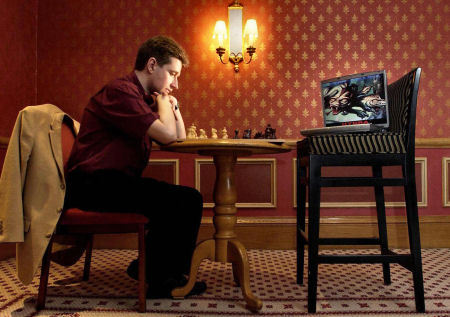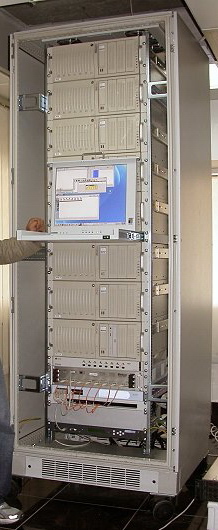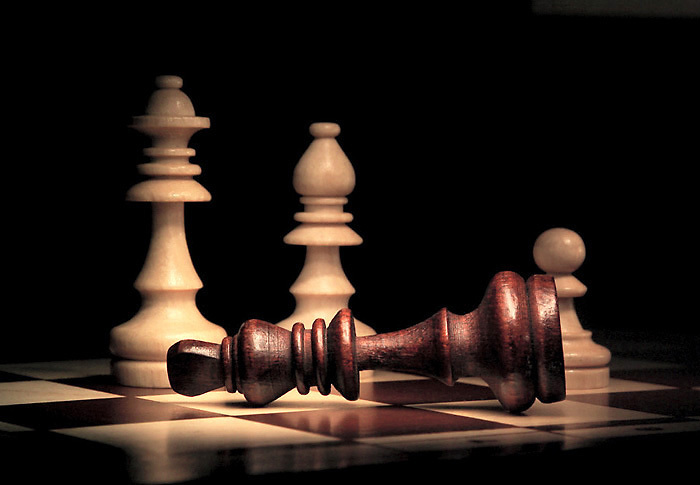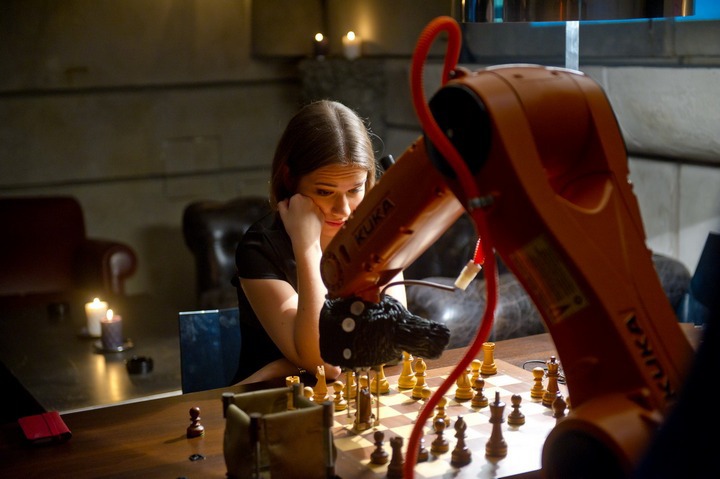After Kasparov. Computer chess - results and prospects
 The final article from the cycle on the opposition of Kasparov with chess machines
The final article from the cycle on the opposition of Kasparov with chess machinesThe match with X3D was the last battle of Harry Kimovich with the machine - he never played with computers in public again. However, his rivalry with people did not last long either. He played in regular tournaments for a couple of years, but in 2005 he decided to end his chess career. From now on, chess became just a hobby for him.
After Kasparov left, there was no clear leader in chess. For several years, the chess crown has been challenged by several grandmasters of equal strength. But in 2013, the young Norwegian Magnus Carlsen climbed to the top. Today he is a world champion and the undisputed leader of world chess.
 Meanwhile, the matches of people and cars continued. In 2004–05, two matches of the leading grandmasters against the best chess programs took place in Spain. Both ended in a victory for the car team, with a score of 3½: 8½ and 4: 8. In the course of the second match, the last one for the current moment also took place, a man’s victory over one of the top programs under the classic game conditions. The honor of such a specific achievement fell on the share of grandmaster Ruslan Ponomarev, who was able to take advantage of the mistake of the program Deep Fritz 9.
Meanwhile, the matches of people and cars continued. In 2004–05, two matches of the leading grandmasters against the best chess programs took place in Spain. Both ended in a victory for the car team, with a score of 3½: 8½ and 4: 8. In the course of the second match, the last one for the current moment also took place, a man’s victory over one of the top programs under the classic game conditions. The honor of such a specific achievement fell on the share of grandmaster Ruslan Ponomarev, who was able to take advantage of the mistake of the program Deep Fritz 9.')
In the summer of 2005, a match took place in London between GM Adams Michael Adams and the Hydra chess machine (in the photo on the left). Traditionally, six games were played. The match ended with a score of 0½: 5½ in favor of the car. All that a man in a match could achieve is one draw.
Finally, the final chord of the confrontation between people and cars was the match between world champion Vladimir Kramnik and the chess program Deep Fritz 10 at the end of 2006. Again the victory of the car - 4: 2.
Despite some hopes of turning the tide, it was gradually becoming clear that the days of man’s confrontation with the machine were numbered. As the algorithms and hardware improved, the advantage of computers became more and more noticeable. After the defeat of Kramnik, the matches of people with cars - at least in the classical format - stopped. Public interest in them almost dried up. Since then, if it was possible to organize such matches, it was only in the "budget" version. The size of the prize pool fell from a few hundred to a couple thousand dollars. Matches are now held with a shortened time control, often against not very strong players. Often a person was given a head start, or a weaker computer was allocated to help. Since then, the chess programs have ceased to be a rival for people, and gradually moved into the category of analytical tools.

In the photo - Vladimir Kramnik plays Deep Fritz 10 with the program.
As with people, the composition of the strongest programs also gradually changed. At the end of 2005, the “old” champions of the old wave, Junior, Fritz, Shredder, and others, replaced the new favorite, the program Rybka. She was far ahead of competitors in all rating lists and for five years no one could challenge her superiority. With each new version, she increasingly gained strength.
In late 2010, Rybka relegated Hudini to second roles, becoming a new, obvious leader among the programs. Having held out at the very top of the world table of ranks for about three years, he in turn gave way to even stronger competitors.
 Since 2014, two programs are considered the best in the world - Komodo and Stockfish. Currently, they are included in the analytical arsenal of almost all leading grandmasters. It is also worth noting that, unlike the commercial Komodo,
Since 2014, two programs are considered the best in the world - Komodo and Stockfish. Currently, they are included in the analytical arsenal of almost all leading grandmasters. It is also worth noting that, unlike the commercial Komodo,  Stockfish is an open source software program. So, it is possible to view its code, or even just watch the process of its improvement. Meanwhile, the level of modern programs continues to grow rapidly and the limit to their perfection is not yet visible.
Stockfish is an open source software program. So, it is possible to view its code, or even just watch the process of its improvement. Meanwhile, the level of modern programs continues to grow rapidly and the limit to their perfection is not yet visible.But back to the issue of confrontation between people and cars. Can the strongest grandmasters beat the best chess programs today?
As mentioned above, normal matches between people and computers have not been held for a long time, so this can only be judged by indirect signs. First of all, this is of course a rating. Modern programs are already more than 500 points stronger than those played once with Kasparov and other grandmasters. Moreover, even without taking into account progress on the part of computing equipment. It should be true to keep in mind that according to the results of years of testing, the increase in the rating of cars is slightly ahead of the human - somewhere in the ratio of 5: 4 or 4: 3. Nevertheless, the safety margin of modern programs is so great that the best of them now, as a rule, easily win over those programs whose defense at one time unsuccessfully tried to crack such chess giants as Garry Kasparov and Vladimir Kramnik. Playing against the once-honored Fritz and Junior, modern programs easily multiply even a very small margin, and without any problems bring it to victory. In general, with the help of old programs and ratings one can make a definite conclusion regarding the strength of the game of modern machines.

But, in addition to the ratings and matches of the programs, the opinion of the grandmasters themselves is undoubtedly important. At least those of them who are currently constantly playing in tournaments or engaged in coaching or analytical work. Today no serious analysis at the “top level” can do without chess programs and leading chess players (not as programmers of course, but as users) can tell a lot about program behavior:
Grandmaster Vladimir Tukmakov:
... In communication between a chess player and a machine, there was a notorious leader - the person who set the search direction, and the program, obediently following the leader's instructions, only made adjustments and clarifications. But in recent years, this ratio has changed dramatically and irreversibly. Now the railway assumed the role of a priest and a guide, leaving the protein substance the opportunity to practically use the recommendations of a higher mind.
Grandmaster Sergey Shipov:
Programs at the end of the first decade of the new century have already become much stronger than people - the best of the best - and this is not subject to doubt among professionals. Each of us uses the best programs in home analysis, we know them as relatives. Even better…
Modern programs (primarily Rybka and Houdini) have a surprisingly balanced and humane evaluation function. They are not as greedy as the programs of the 90s. Thinly feel the initiative, competently work with the pawn structure, take into account all the important strategic factors ...
In general, decades of hard work of programmers and professional chess players were not in vain. Together they created almost perfect players, far superior to us, living people. It is a fact.
Grandmaster Sergey Karyakin:
... I sometimes fight with the program "Houdini" and can compare. In a duel against a computer, the feeling of doom does not leave you ...
Is a man-car match possible today? How can he be? Let's try to evaluate options for such a competition.
First, it should be noted that all sorts of light parties are held in our days. But for a serious match you need a solid prize fund, which is hardly possible with modern public interest. But even if we leave aside financial issues, then in a probable match a person will have to give some kind of a head start - in time or in material. Otherwise, he is unlikely to agree to play. The handicap of the material (of course, this is about the top grandmasters) is likely to result in one or two pawns, or their bargaining equivalent from other pieces. Unfortunately, the size of the material handicap, apparently not too affected by the strength of the game the best of modern programs. What naturally makes senseless comparison of these programs with people.
You can, in turn, give odds not on the material, but let's say by reducing the time of the machine. But in order for a modern program to slow down to the level of computers in the first half of the 2000s, it will take about 1 second to move it to a good modern smartphone. This kind of “fit” of the rivals' power in general deprives the very meaning of the competition between man and machine. At best, we will determine how much time odds are needed for rivals to really equalize in strength. But only.
What other options are there? The absence of a computer’s debut book will not help a person much , as cars play without it. From the removal of the endgame tables, the gain will be even less . The repetition of moves from previous games is largely excluded, due to the noticeable “randomness” of the accompanying chess programs on multi-core systems. If, on the other hand, a weak program is given to help a person, the question immediately arises of how great the role of the machine is in the results of the person. In general, it is difficult to imagine any obvious and interesting forms of computer games today.
Summing up, we can say that the time of high-profile matches between people and cars has finally become a thing of the past. The computer today is not an opponent, but an assistant of people. Under the influence of machines, and not only them, modern chess is gradually changing. What this will lead us to see with you.

Previous Cycle Articles
Kasparov - Deep Thought. One gate play
The first offenders. Fritz and Genius
Kasparov vs. Deep Blue. Part I: Black Box
Kasparov vs. Deep Blue. Part II: The Philadelphia Experiment
Kasparov vs. Deep Blue. Part III: Mezhmatche
Kasparov vs. Deep Blue. Part IV: New York Secrets
Kasparov vs. Deep Junior. Return to New York
Chess 3D-show: Kasparov VS Fritz
The first offenders. Fritz and Genius
Kasparov vs. Deep Blue. Part I: Black Box
Kasparov vs. Deep Blue. Part II: The Philadelphia Experiment
Kasparov vs. Deep Blue. Part III: Mezhmatche
Kasparov vs. Deep Blue. Part IV: New York Secrets
Kasparov vs. Deep Junior. Return to New York
Chess 3D-show: Kasparov VS Fritz
See also:
- An article about the principles of the work of chess programs from Randl
- The latest edition of the Russian translation of the book "Behind Deep Blue" (pdf + doc): the links one , two , three .
Source: https://habr.com/ru/post/377377/
All Articles
